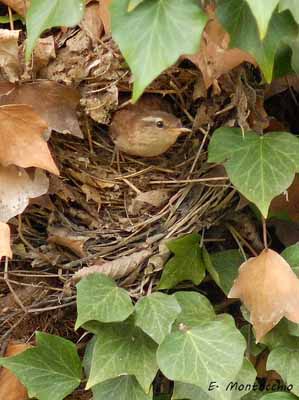
Winter Wren – Troglodytes troglodytes
Passeriforme Order - Troglodytidae Family
BIOMETRICS:
Length: 8- 2 cm; Wingspan: 12-16 cm; Weight: 8 à 12 g
LONGEVITY: 4 years
DESCRIPTION:
Winter Wren is a minuscule, almost uniform dull brown bird. The upperparts are reddish-brown, finely barred with dark brown on wings, tail and rump. The short tail is rounded, chestnut or reddish-brown, finely streaked with dark brown.
The underparts are paler on chin, throat and breast. Flanks and belly are heavily streaked with reddish and brown or blackish.

Head and nape are darker than upperparts, more uniform, almost without streaks. An inconspicuous pale supercilium extends from the base of the bill to the rear eyes.
The bill is relatively long, slender and slightly down curved. It is two tones with blackish upper mandible, and pale yellow or bone lower mandible.
The eyes are dark brown. Long and strong legs and feet are pale brown.

Winter Wren is the only member of the Wren family which occurs in Eurasia, others being in the Americas.
Both sexes are similar.
Juvenile is more reddish, with head and nape slightly streaked with blackish edges. Underparts are darker, streaked with dark brown.
First year has brown streaked alula, whereas adults have conspicuous white edges on it.
Subspecies of Winter Wren are paler in hot and desert areas than in wet and cool regions.
VOICE: SOUNDS BY XENO-CANTO
Winter Wren’s song is very loud and strong for a tiny bird. The song is a mixture of trills and rattling warblers, ending in prolonged dry rattling trill. Call is a harsh low “churr”, and also a loud “tek” often repeated.
During autumn, Winter Wren songs softly, but its alarm call is very strong “terrerrerr”, and also a rapid tremolo “titititic”, in all seasons.

HABITAT:
Winter Wren lives in various habitats such as woodlands, gardens, farmlands, rocky islets, cliffs on islands.
RANGE:
Winter Wren is found in Centre and south of Canada, Alaska, West coast of United States, Europe, Asia to Japan and North Africa.
Northern birds migrate southwards to winter. In Taiwan, it is a common resident of mountain forests, at mid to high elevations.
BEHAVIOUR:
Winter Wren sings from the top of a shrub, or horizontal branch, but also hidden in trees. When excited, it starts to sing in flight, but it rapidly alights to finish its phrase, before to start other song.
To feed, Winter Wren forages on the forest floor, and along the banks of streams. It is often flitting from bush to bush, or running as a mouse on the ground.

It bobs its head almost continuously, and hops on the ground with cocked tail. It moves quickly, constantly flicking its erect tail, and bending its breast downward.
When spring is coming, the male builds several nests, and encourages a female, or females, to select one. If the male is monogamous, it will help the female to raise the young. But if it is polygamous, it will be too busy, defending its territory. It attracts female by vocalizations. She inspects the nests and when one is chosen, she helps the male to line it with feathers and hair. Other nests serve to lure predators.
At night, in winter, it roosts in dark retreats, holes or old nests. If night is cold, they roost in small groups gathered together for warmth.
FLIGHT:
Winter Wren has a whirring direct and low flight. It rapidly dives back into cover. It also may perform weak fluttering flights of short duration.
REPRODUCTION:
The male builds 3 to 4 nests, and the female chooses one. The nest is made with sticks and moss, by male, and female helps it to line the interior with feathers and hair. The nest is located in an old stump or woodpecker cavity or rock crevice. It is a covered, down-shaped structure, with an entrance on the side, giving the name “troglodytidae”, meaning “cave dweller”.

The female lays 4 to 7 white eggs, spotted with brown. Incubation lasts about 12 to 16 days, by female. Chicks are altricial, with sparse grey down on head and back. Both parents feed and protect the young. They fledge three weeks later, and parents feed them for up to 40 days more, giving them chances for survival.
This species may produce two broods per season, between April and July.

DIET:
Winter Wren feeds on a wide variety of invertebrates, such as insects and spiders, but also small vertebrates such as fishes, tadpoles and young frogs. It also consumes berries and seeds.

PROTECTION / THREATS / STATUS:
Winter Wren populations are generally stable, even increasing in most of range. Birds living in western North America are threatened by habitat loss with fragmentation of coniferous forests. Winter Wren is sometimes a host of the Brown-headed Cowbird.
Fr: Troglodyte mignon
All: Zaunkönig
Esp : Chochín Común
Ital: Scricciolo comune
Nd : Winterkoning
Russe: Крапивник
Sd : Gärdsmyg
Photos d’Eugène Montocchio
Son site : Galerie Photos Nature
Text and photographs by Nicole Bouglouan
Sources:
THE HANDBOOK OF BIRD IDENTIFICATION FOR EUROPE AND THE WESTERN PALEARCTIC by Mark Beaman, Steve Madge - C.Helm - ISBN: 0713639601
THE COMPLETE BOOK OF BRITISH BIRDS – Written by “Royal Society for the Protection of Birds” experts - Préface de Magnus Magnusson - Michael Cady- Rob Hume Editors - ISBN: 0749509112
WRENS, DIPPERS AND THRASHERS by Brewer David – illustrated by Barry Kent Mackay- Yale University Press - ISBN: 0300090595
All About Birds - Cornell Lab of Ornithology
Arthur Grosset's Birds (Arthur Grosset)
Bird Web (Seattle Audubon Society)
What Bird-The ultimate Bird Guide (Mitchell Waite)
Wikipedia (Wikipedia, The Free Encyclopedia)

